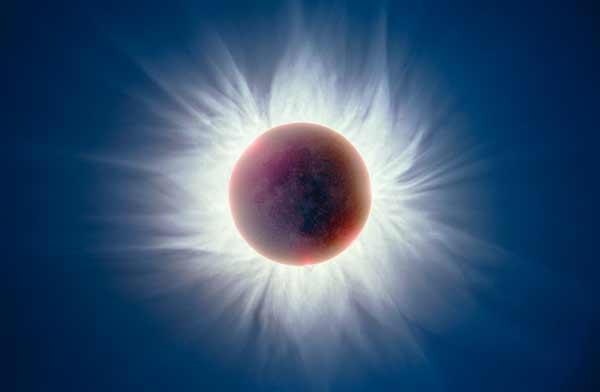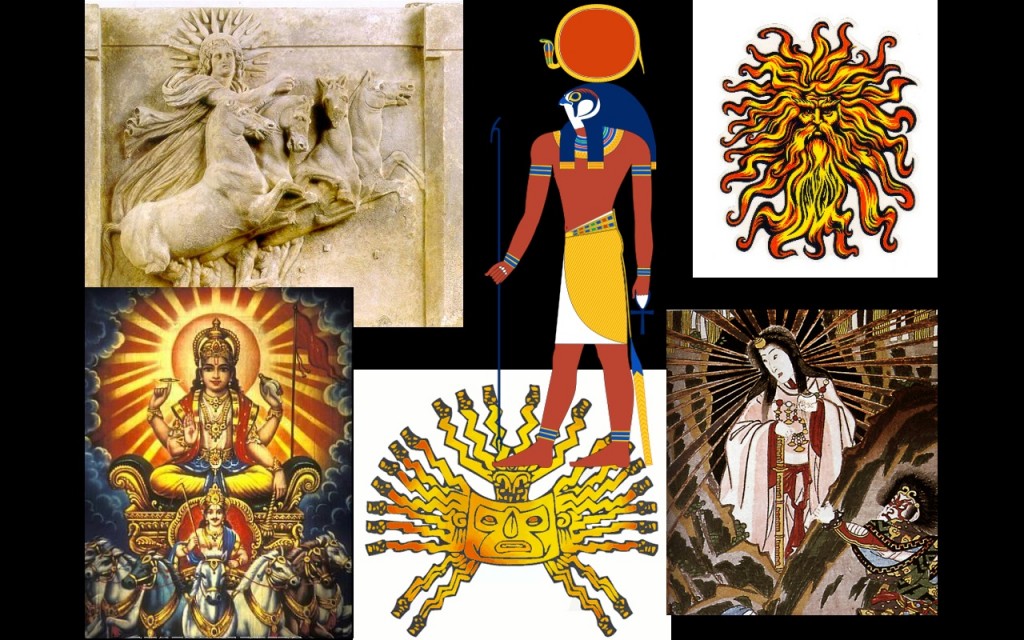HJ: There is no separation between our consciousness and the sun. The two are inextricably linked, a fact which ancient societies understood quite well…
After all, our entire sleep wake cycle is dictated by the sun. Sunlight activates the optic nerve in our eyes, which is directly connected to the pineal gland, which is then triggered by the incoming light to produce an entire cascade of hormones that intimately regulate or sleep/wake cycle and every single aspect of the functioning of our bodies. Clearly, we could not exist without the sun.
The food we eat exists because of the suns energy. Eating plants or animals (which eat plants or other animals that eat plants), is a way for us to consume sunlight in a useable form. Sunlight hitting our skin produces Vitamin D, one of the most important nutrients for happiness, health, immunity and energy…
If you have some time to ponder on the nature of existence, in one way or another, you can trace the existence of any one thing back to the existence of our sun or other stars somewhere in the Universe.
As such a major part of our life, it’s probably worth understanding the relationship between our consciousness and the sun a bit more thoroughly, don’t you think? And for that, we turn to Gregory Sams and his beautiful piece on Stardust and Stellar Consciousness…
– Truth
Stardust and Stellar Consciousness
By Gregory Sams | Infinite Connections
—

© Fred Espenak
Have you ever wondered why your spirits are lifted on a sunny day and not in a hot bright room – or paused to consider that the energy of your life is itself the recycled light of the Sun? Have you spent more of your life thinking about suntans, sunglasses and sun block than about the nature of the star in your movie – the movie of Life? As you read these words, the energy that moves your eyes and the energy with which you comprehend their meaning is the light of our Sun being expressed through a new medium: you.
Is there any reason why we cannot consider whether that which brings us the light of life might be conscious of life itself? Scientists who may argue over whether or not consciousness is an illusion will agree that it is one of the greatest mysteries of our existence. This, even though it is consciousness that is seeking to understand itself. So how can we be sure that nothing else experiences this mysterious experience that we cannot understand? We cannot be sure; we simply perpetuate a well-entrenched Church tradition. Scientific thought seems not to entertain the idea, dismissing it out of habit.

Sun gods
The default mode for humanity was always to see our Sun as a conscious entity with divine status. This was the case across the globe, regardless of which culture or century you choose to visit – until Christianity and the Roman Empire combined in the 4th Century. It was not science that made us look on Sun worship as primitive and ignorant, but the Roman Church who took a very dim view of anybody who disagreed.
So unlike the Ancients, we now view the Sun as some dumb ball of hot gas that just happens to provide us with the light of life. But science has found out an awful lot about this hot ball of plasma (it’s not actually gas) and its stellar siblings.
Unlike the ancients, we know Sun and others stars turn simple hydrogen and helium into all the elements that make up us and the world around us – from carbon and oxygen, to iron and gold. They are the transmutation engines of the cosmos. By weight, 93% of the matter in your body was once stardust.
We know that stars turn matter itself into the energy of light, agent of the electromagnetic force. Light informs us of the world around us and brings it energy. Light is the catalyst in photosynthesis, when the atoms of air and water molecules are re-arranged into the basic building bricks of the entire vegetable world, on the land and in the sea. During this, the energy of Sun’s light is stored in plants and their seeds, transferring to us when we eat those basic foods, or another animal that ate them. This is the energy that powers life and consciousness.
We are stardust, powered by starlight. This much we know.
Unlike the ancients, we know that stars are complex and interconnected balls of plasma. Our Sun has seven distinct layers, all performing different functions with some of them rotating around each other at different speeds. Its powerful corona, an invisible energy field, occupies more space than Sun itself and is thought to manage various solar features including sunspots, solar flares, coronal filaments, and coronal mass ejections. We identify and measure electro-magnetic field lines connecting the corona to Earth, and NASA recently discovered a magnetic portal the diameter of Earth that connects Sun’s corona to our planet, through which tons of high-energy particles pass at eight minute intervals. We know that the solar wind spinning off Sun’s corona twists into a giant electromagnetic bubble, the heliosphere, which embraces and protects the solar system as it travels through the galaxy at nearly 500,000 miles per hour. Scientists rank Sun’s corona as its most mysterious feature. Perhaps it is as great a mystery as human consciousness.
Unlike the ancients, we know that all those stars in the night sky are related to our Sun. We see that most stars live as couples, called ‘binary systems’ by astronomers, and that they are not scattered randomly but live in communities called “stellar clusters.” Every star sends its own unique signature note out into space, and is connected to other stars via electromagnetic fields that criss-cross the galaxy. Electromagnetic fields have now been discovered spanning deep space, connecting galaxy to galaxy. We humans use the photons expressed through electromagnetism in virtually all the technology involving information transfer, from smart phones to wi-fi, optic cables to MRI scans. Light is the medium of sight. Our cells use photons to communicate with each other and photons are expressed by neurons in our brains. We find plants communicating with photons as well. It does not seem far-fetched to consider that the photons of these little-understood electromagnetic fields linking stars and galaxies are there for the same purpose – exchange of information.
Perhaps, if scientists abandoned that old religious taboo against considering consciousness in anything other than us or things like us, they would not need fixes like “dark matter” to explain why galaxies refuse to behave like accidental mechanical systems. NASA describes “dark matter” as the name given to the solution for a problem that has not yet been solved. Perhaps the reason galaxies don’t fall apart is because they are not stupid balls of gas, but a joined up community of intelligent super-beings. Just a thought.
It is not that Sun’s behaviour absolutely proves it, and other stars, to be conscious beings, just that from an unbiased viewpoint, scientific or otherwise, this seems the most likely option. It is the default option we always held until it was burned from our culture, literally, by a jealous Church. Now, with the data to hand and burning at the stake out of vogue let us reconsider this idea with an open mind.
Unlike us, the ancients gave great importance to the influence of stars and planets upon the course of our lives. Perhaps they knew something that would bring added value to what we now know of the cosmos. Stellar consciousness does change everything. And from the personal perspective, can there be anything more important to our spiritual health than recognizing who stars in the movie of life?
Gregory Sams is available for radio and TV interviews as well as conference speaking and events. For further information visit his page: Infinite Connections












